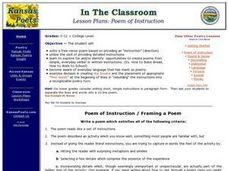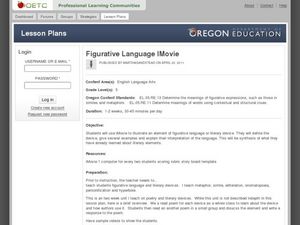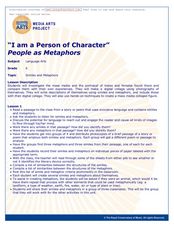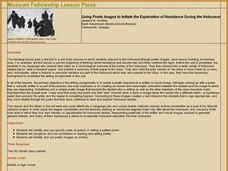Curated OER
Poem of Instruction
Students write a free-verse poem and utilize the skill of providing detailed instructions. identify opportunities to create poems from simple, everyday verbal or written instructions. They study everyday language that has merit as poetry.
Curated OER
Deciphering the Mechanics of Poetry
Eighth graders study poetic devices and use them in their own writing and apply them when reading poetry. In groups, they describe an item using poetic devices.
Curated OER
Reflecting/Writing after a field trip or other experience
Students reflect on field trips in writing. In this journal writing lesson, students write about a recent experience by using 4 of their senses to tell what they remember. They turn these into poetry.
Curated OER
Simile Stories
Fourth graders view song lyrics and identify similes in the song text. In this similes lesson, 4th graders define and identify similes on a worksheet. Students write their own similes using various adjectives.
Curated OER
Can You Figure Language?
Eighth graders study similes and metaphors and how to explain and create them. After a lecture/demo, 8th graders access websites and worksheets imbedded in this plan to create their own writing.
Curated OER
Introduction to Poetry
Students determine the rhyme scheme of a poem and find examples of similes. In this poetry analysis lesson, students review definitions needed for the topic and analyze the rhyme or rhythm for the example poems. Students also find...
Curated OER
Fall Similes
Students create descriptive autumn similes and write them on fall-themed paper. They first write the autumn simile, and then arrange the plants around the border of the paper. They use natural plants which must be pressed.
Curated OER
It's All Poetry to Me!
Fourth graders explore language arts by analyzing poetry styles. In this writing analysis lesson, 4th graders read several sample poems in class and identify similes, metaphors and other figurative language within them. Students analyze...
Curated OER
Figurative Language iMovie
In order to understand figurative language, learners read 5 poems, each exemplifying a different literary device. They discuss and write responses to each poem. They then choose one literary device which they will use as the basis for a...
Curated OER
Figurative Language
What is figurative language, and why do we use it? Introduce your high schoolers to some examples and discuss the importance of including this element in your writing. After studying a text and searching for examples, writers will...
Curated OER
Similes and Metaphors
Students explore similes and metaphors. They discuss and define similes and metaphors, identify the similes and metaphors in two poems, and create three original examples of each.
Curated OER
Introducing 'Communication Talent' with "Casey at the Bat"
Students listen to the poem "Casey at the Bat". They use their Forecasting Skill to answer questions and discuss the poem.
Curated OER
Writing a poem
Young scholars imagine themselves someplace -- the beach, a mountain top, a city street -- anywhere.
Curated OER
Christmas Poetry
Students explore writing using literary terms. In this Christmas poetry lesson, students write a poem about a Christmas tree or a snowman using at least one example of each: metaphor, simile, and personification.
BBC
The Role of a Monarch (key stage 2 and 3)
What makes a good monarch? Elementary and middle schoolers examine popular symbols of the British monarchy before designing a television advertisement about the qualities needed in a monarch. Next, they write poems using metaphors and...
Reed Novel Studies
Out of My Mind: Novel Study
Have you ever felt trapped in your own body? That is likely how Melody in Sharon M. Draper's Out of My Mind feels. As scholars read to find out how Melody finally expresses herself, they complete sentences with new words, describe...
Reed Novel Studies
Walk Two Moons: Novel Study
Enjoy solving riddles? Perhaps Sal, a character in Walk Two Moons, is the only one capable of understanding a mysterious message left on her doorstep. On a road trip with her grandparent, Sal tries to make sense of the bizarre world...
Reed Novel Studies
Ruby Holler: Novel Study
A journey of a lifetime awaits you in Ruby Holler. Troublesome orphaned twins pair up with an older couple for a magical adventure. However, the journey must begin with the pairs staying together in Ruby Holler. Scholars soon learn of...
Scholastic
Comprehension During Independent Reading
Ideal for a language arts class, literary unit, or independent reading assignment, a set of reading worksheets address a wide array of skills. From poetic elements to nonfiction text features, you can surely find a valuable resource in...
Curated OER
I Am a Person on Character
Sixth graders explore the portrayal of males and females in mass media. For this language arts lesson, 6th graders create a digital collage and write a description about themselves using similes and metaphors.
Curated OER
Getting to Know My Apple
First graders compare an apple to unlike things in a simile poem. ie: The apple tastes sour like a lemon. When poems are complete, have students share their simile poems with the class and finish eating their apples.
Curated OER
Flowers, Flowers, Flowers...A Visit with Georgia O'Keeffe
Students analyze, discuss, and research Georgia O'Keeffe and her flower paintings. They select a flower to paint and create a watercolor painting in the style of Georgia O'Keeffe. Students compose a poem describing their painting.
Curated OER
Where's Walden and Why Henry?
Sixth graders understand how Thoreau can serve as both inspiration and model for the investigation of home places. They explore ways to become better observers of natural and cultural history. Students find out how to connect with their...
Curated OER
Using Poetic Images to Initiate the Exploration of Resistance During the Holocaust
Students explore the role of resistance during the Holocaust. Viewing images, they complete a set of notes on the Holocaust and discuss the feelings they get from looking at the photographs. They identify the parts of speech used in...























